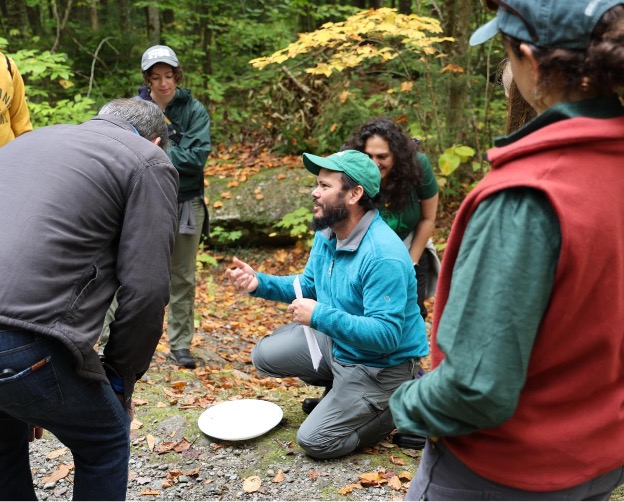Climate Change and Cyanobacteria: UVM's Cutting-Edge Research on Lake and Stream Health
Jan. 15th 2025Have you ever seen a green mass in the water that resembles spilled paint or pea soup? If so, you’ve probably spotted a cyanobacteria bloom. This bloom is an overgrowth of cyanobacteria – a photosynthetic bacteria – that multiplies when the water is warm, stagnant, and rich in nutrients, such as nitrogen and phosphorus. While cyanobacteria are naturally occurring and essential, cyanobacteria blooms can be detrimental to lake ecosystems and can be toxic to animals and humans. The bacteria become harmful when they grow rapidly due to unnaturally high levels of nutrients from fertilizer, sewage, or runoff.
The University of Vermont (UVM) has recently received funding from the U.S. Geological Survey (USGS) to tackle cyanobacteria and other water resource challenges. The project, Dynamics of Algal Populations and Alteration by Extreme Hydrologic Regimes, aims to better understand the factors driving cyanobacteria blooms in lakes. As climate change exacerbates the impacts of nitrogen and phosphorus eutrophication, this research is crucial to predicting and mitigating the effects of these harmful blooms.
The research is funded by The Water Cycle Center, a collaboration between U.S. Geological Survey and academic partners that advances the understanding of processes that determine water availability and future water resource challenges.
Leading the research is Principal Investigator, Ana "Mindy" Morales-Williams, an Associate Professor at UVM’s Rubenstein School of Environment and Natural Resources and Interim Director of the Rubenstein Ecosystem Science Laboratory in collaboration with Co-Investigator Dr. Pablo Gutiérrez-Fonseca, Lecturer in the Rubenstein School.
Dr. Morales-Williams explains that while nutrients are the primary driver of cyanobacteria blooms, the effects of climate change are amplifying these processes, making bloom events difficult to predict. "Climate change processes and extreme events, like heat waves, droughts, or floods change the rate, timing, and amount of what enters lakes," she says.
The Role of Climate Change in Water Quality
Climate change is having profound effects on waterways, and in turn, on water quality. “It’s not just individual extreme weather events that trigger amplified impacts, but the sequence or co-occurrence, and potentially synergies of multiple extreme events that intensify their impact on aquatic ecosystem function,” says Morales-Williams. During floods, nutrients such as nitrogen and phosphorus are carried from agricultural lands into surrounding rivers and streams. This nutrient overload fuels the growth of cyanobacteria—a photosynthetic organism that thrives on these nutrients, particularly in freshwater and marine environments. More frequent and intense rainstorms and weather events, like the severe flooding Vermont has experienced in recent years, increases nutrient loading.
This suite of nutrients allows the bacteria to accumulate into dense blooms, covering the surface of freshwater and marine environments, disrupting ecosystem functions and degrading water quality. When lakes are in heavily developed agricultural watersheds, they often receive significant amounts of fertilizer through tributary runoff, which provides a rich nutrient source for cyanobacteria. These blooms respond rapidly to environmental changes, and since lakes are part of watershed systems, extreme weather events can have cascading impacts on ecosystems and downstream communities.
Understanding Resilience in Streams and Lakes
The UVM research team is working to understand how resilient the streams and tributaries are to these climatic events in terms of nutrient cycling, carbon cycling, and community composition of benthic invertebrates and benthic algae in the streams. By uncovering the responses of tributaries and lakes to extreme storms, the team hopes to better predict and mitigate the climate-driven feedback loops that may amplify cyanobacteria blooms.
Morales-Williams is conducting this research downstream in Shelburne Pond, while her co-investigator, Gutiérrez-Fonseca, an ecologist in the Rubenstein School, is focusing on stream ecosystems. Together, they are investigating the lag time between disturbances in streams and the corresponding effects on lakes—particularly in terms of cyanobacteria blooms and their cascading effects on watershed-scale ecosystem functions.
A New Tool for Real-Time Data: The Data Buoy
In the coming spring, the team will deploy a cutting-edge data buoy in Shelbourne Pond. The buoy, which will collect real-time measurements every 15 minutes, will track key parameters such as dissolved oxygen, temperature, pH, carbon dioxide, and methane levels. A weather station attached to the top of the buoy will measure rainfall and barometric pressure. This buoy will provide an unprecedented level of detail on how events influence lake and stream communities. Morales-Williams is particularly excited about the potential of this data, stating that it will offer “a high-resolution picture of what happens over time, biologically, chemically and physically in the lake.”
After extreme weather events, the buoy’s data will help the team analyze how the intensity and sequence of disturbances impacts community turnover in both stream and lake ecosystems. Differing from the currently deployed data buoy, this one will be stationed at the deep spot in the pond and will live stream to the web. The information will be accessible in real-time via a public interface, providing valuable insights to anyone interested in water quality monitoring at Shelburne Pond.
Fieldwork and Student Involvement
The project’s first field season took place this past summer, and the team is currently processing their phytoplankton samples. Morales-Williams and Gutiérrez-Fonseca are accompanied by UVM RSENR MS student Jo Delahunt and undergraduates Emma Polhemus and Ollie Leibovich, who are contributing valuable fieldwork and data analysis support.
By better understanding how weather events impact nutrient cycling and cyanobacteria blooms, this research promises to provide vital insights into managing water resources as extreme hydrologic events persist. Ultimately, the work will further strategies to protect freshwater ecosystems and the communities that depend on them.
 ecoNEWS VT
ecoNEWS VT